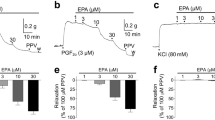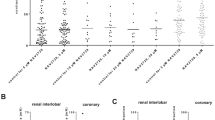Summary
Bradykinin (BK) initially produced concentration-related relaxations of human basilar artery in vitro. Concentration-effect curves constructed at 2 h intervals to BK over an 8 h period were reproducible. The rank order of potency of three kinins on the human basilar artery was found to be BK > methionyl-lysyl-BK > des-Arg9-BK. The B2-receptor antagonist Thi5,8 d-Phe7-BK but not the B1-receptor antagonist des-Arg9-Leu8-BK selectively blocked BK-induced relaxations of the human basilar artery.
The relaxant effects of bradykinin and acetylcholine but not papaverine were attenuated after removal of the endothelium or treating the tissues with BW755C. Indomethacin was without effect. Concentration-effect curves to angiotensin I were markedly attenuated by captopril at a concentration which had no effect on BK, angiotensin II or 5-hydroxytryptamine responses. It is concluded that BK induced relaxations of the human basilar artery are mediated via activation of a B2 receptor and the response is dependent upon the release of a factor present in the endothelium. Angiotensin converting enzyme is present in the human basilar artery and is important for the conversion of angiotensin I to angiotensin II but apparently not for the degradation of BK. It is likely that other kininases are present and active in the tissue.
Similar content being viewed by others
References
Babuik C, Marceau F, St Pierre S, Regoli D (1982) Kininases and vascular responses to kinins. Eur J Pharmacol 78:167–174
Barabé J, Drouin J-N, Regoli D, Park WK (1977) Receptors for bradykinin in intestinal and uterine smooth muscle. Can J Physiol Pharmacol 55:1270–1285
Barabé J, Marceau F, Thériault B, Drouin J-N, Regoli D (1979) Cardiovascular actions of kinins in the rabbit. Can J Physiol Pharmacol 57:78–91
Caldwell PRB, Seegal BC, Hsu KC, Das M, Soffer RL (1976) Angiotensin converting enzyme: vascular endothelial localisation. Science 191:1050–1051
Cherry PD, Furchgott RF, Zawadzki JV Jothianandan D (1982) Role of endothelial cells in relaxation of isolated arteries by bradykinin. Proc Natl Acad Sci USA 79:2106–2110
Cushman DW, Cheung HS, Sabo EF, Ondetti MA (1977) Design of potent competitive inhibitors of angiotensin-converting enzyme — carboxyalkanoyl and mercaptoalkoanoyl amino acids. Biochemistry 16:5484–5491
Erdöis EG (1979) Kiniases. In: Erdfis EG (ed) Handbook of experimental pharmacology, Supplement to vol 25. Springer, Berlin Heidelberg New York, pp 427–487
Erdös EG, Sloane EM (1962) An enzyme in human blood plasma that inactivates bradykinin and hallidin. Biochem Pharmacol 11:585–592
Furchgott RF (1981) The requirement for endothelial cells in the relaxation of arteries by acetylcholine and some other vasodilators. TIPS 2:173
Furchgott RF, Zawadzki JV (1980) The obligatory role of endothelial cells in the relaxation of arterial smooth muscle by acetylcholine. Nature 288:373–376
Gimbrone MA, Majeau GR, Atkinson WJ, Sadler W, Cruise SA (1979) Angiotensin-converting enzyme activity in isolated brain microvessels. Life Sci 25:1075–1084
Hardebo JE, Hanko J, Kahrström J, Owman C (1985) Endothelium dependent relaxation in cerebral arteries. J Cereb Blood Flow Metabol 5 (Suppl 1):5533–5534
Kamitani T, Little MH, Ellis FF (1985a) Evidence for a possible role of the brain kallikrein-kinin system in the modulation of the cerebral circulation. Circ Res 57:545–552
Kamitani T, Little MH, Ellis EF (1985b) Effect of leukotrienes, 12-HETE, histamine, bradykinin and 5-hydroxytryptamine on the in vivo rabbit cerebral arteriolar diameter. J Cereb Blood Flow Metabol 5:554–559
Regoli D, Barabé J (1980) Pharmacology of bradykinin and related kinins. Pharmacol Rev 32:1–46
Ryan VS, Ryan JW, Whitaker C, Chin A (1976) Localisation of angiotensin converting enzyme (kininase II). II. Immunoreactivity and immunofluorescence. Tissue Cell 8:125–145
Schild HO (1973) Receptor classification with special reference to the beta adrenergic receptors. In: Rang HP (ed) Drug receptors. University Park Press, Baltimore, pp 29–36
Sternberger LA, Hardy PH Jr, Cuculis JJ, Meyer HG (1970) The unlabelled antibody enzyme method of immunohistochemistry. J Histochem Cytochem 18:315–333
Taylor GW, Morris HR (1983) Lipoxygenase pathways. Br Med Bull 39:219–222
Toda N (1977) Actions of bradykinin on isolated cerebral and peripheral arteries. Amer J Physiol 232:H267-H274
Unterberg A, Wahl M, Baethman A (1984) Effects of bradykinin on permeability and diameter of pial vessels in vivo. J Cereb Blood Flow Metabol 4:574–585
Unterberg A, Dautermann C, Baehmnn A, Müller-Esterl W (1986) The kallikrein-kinin system as mediator in vasogenic brain oedema. J Neurosurg 64:268–276
Vane JR (1971) Inhibition of prostaglandin synthesis as a mechanism for aspirin-like drugs. Nature New Biol 231:232–235
Vavrek RJ, Stewart JM (1985) Competitive antagonists of bradykinin. Peptides 6:161–164
Wahl M, Young AR, Edvinsson L, Wagner F (1983) The effect of bradykinin on pial arteries in vitro and in situ. J Cereb Blood Flow Metabol 3:231–237
Wahl M, Unterberg A, Whalley ET, Baethmann A, Young AR, Edvinsson L, Wagner FFW (1986) Cerebrovascular effects of bradykinin. In: Owman C, Hardebo JE (eds) Neural regulation of brain circulation. Elsevier, Amsterdam, pp 419–430
Whalley ET, Wahl M (1983a) Analysis of bradykinin receptor mediating relaxation of cat cerebral arteries in vivo and in vitro. Naunyn-Schmiedeberg's Arch Pharmacol 323:66–71
Whalley ET, Wahl M (1983b) Angiotensin converting enzyme, bradykinin and cat cerebral vessels. Pflügers Arch 398:175–177
Whalley ET, Fritz H, Geiger R (1983a) Kinin receptors and angiotensin converting enzyme in rabbit basilar arteries. Naunyn-Schmiedeberg's Arch Pharmacol 324:296–301
Whalley ET, Wahl M, Sampaio CAM (1983b) Angiotensin converting enzyme, bradykinin, angiotensin and cerebral vessel reactivity. Hypertension 5 (Suppl V): V34-V37
Author information
Authors and Affiliations
Additional information
Send offprint requests to E. T. Whalley at the above address
Rights and permissions
About this article
Cite this article
Whalley, E.T., Amure, Y.O. & Lye, R.H. Analysis of the mechanism of action of bradykinin on human basilar artery in vitro. Naunyn-Schmiedeberg's Arch Pharmacol 335, 433–437 (1987). https://doi.org/10.1007/BF00165559
Issue Date:
DOI: https://doi.org/10.1007/BF00165559




